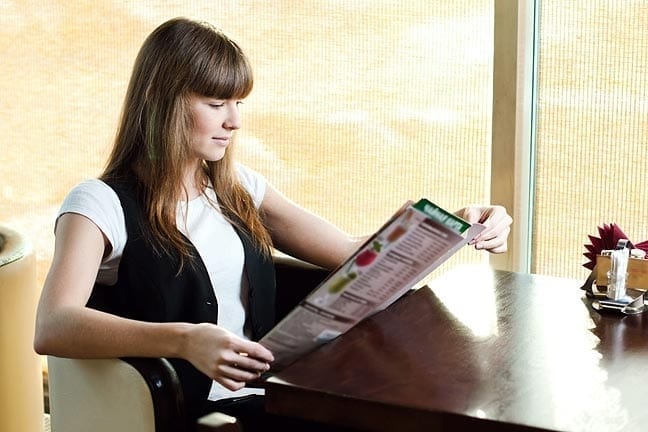When you hungrily open the menu at a restaurant, have you ever wondered whether your choices are influenced by your stomach or by how the menu itself is designed?It has long been believed that restaurant menus have a “sweet spot,” a place where a diner’s eyes are uncontrollably drawn to and then linger. It’s also been suggested that items that are boxed or highlighted are more likely to draw your attention.But while all this sweet talk may be romantic, it’s actually more menu design lore than something based on scientific research.MORE: Is Wheat Causing Your Skin Woes? Or so says San Francisco State researcher Sybil Yang, who discovered there were no stats to back up these menu design theories in her days as a restaurant consultant. “I was often asked for design and layout advice in order to maximize sales,” explains Yang. “When I looked for empirical research to support what I had read in the trade press on the subject, I couldn’t find any.”
 |
The only data she found behind the “sweet spot” theory was by graphic designer William Doerfler, who claimed in the 1970s that people are instinctively drawn to the upper-right corner of a two-panel menu. It soon became conventional wisdom in the restaurant industry that this space is prime real estate on a menu—and where restaurants should place the items they most want to sell.But judging from personal menu reading experience, Yang wasn’t so convinced. She decided to conduct her own research, where she actually discovered the contrary: There is no “sweet spot.” Diners read menus sequentially like a book, from top to bottom on each page. In her research, test subjects wore an infrared retinal eye scanner, perused a mock menu and then choose a full meal as if they were dining at a restaurant. Besides reading sequentially, she also found they read slowly, which suggests that they were reading for information, rather than just quickly scanning the pages.
 |
Yang found no evidence of a specific area where eyes focused for longer amounts of time, but she did notice a not-so-sweet spot—an area where readers focused their attention for the least amount of time: the section on salads. She also noticed that subjects were more likely to choose an entrée first and then build a meal around it. Yang’s advice to restaurant menu designers: “I would presume to say the most important area is wherever the entrees are and not limit it to any particular fixed location.”MORE: Omega-3 Foods to Fight AgingWhile there are many theories that claim to crack the code for profitable menu design, Yang is quick to point out that many lack scientific research. For example, the popular primacy and recency theory—which states that customers usually purchase the first and last two items listed under each category (i.e. appetizers, entrees, desserts)—hasn’t proven out as an effective tactic in boosting sales.One study tested this theory and, according to Yang’s analysis, found it only held true for items in the appetizer category. “The ‘first and last’ positions selling more did not occur with entrees, desserts or general beverage categories,” she says.So what are some other ways your menu choices are under the influence? Yang is currently testing her “decoy theory,” which revolves around the idea that certain items are placed on a menu solely to sway you into choosing another. “You see this with size offerings,” says Yang. “For example, a small or extra-large beverage may be created and priced to push people to buy a medium or large beverage.”Another decoy trick involves calorie counts to influence your order—and quash the guilt over choosing high-calorie treats. “Theoretically, states with calorie count laws could put a decoy high-calorie item on the menu to make other items look more reasonable in terms of their calories,” explains Yang. “All of a sudden, a 400 calorie cookie doesn’t look so bad when placed next to a 1,200 calorie cupcake.”MORE: Can You Get Youth-Boosting Food Benefits in a Pill?




































